Will Ir Block Lens Work On Ir Sensitive Camera?
Infrared, or "IR" photography, offers photographers of all abilities and budgets the opportunity to explore a new globe – the world of the unseen. Why "unseen"? Considering our eyes literally cannot see IR lite, as information technology lies just beyond what is classified as the "visible" spectrum – that which human eyesight tin can detect. When nosotros take photographs using infrared-equipped moving picture or cameras, we are exposed to the world that can oft wait very dissimilar from that we are accepted to seeing. Colors, textures, leaves and plants, man peel, and all other style of objects can reverberate IR calorie-free in unique and interesting ways, ones that cannot be mimicked with tools such equally Photoshop (yes – there are limits to what Photoshop can practise!).
Similar any class of photography or fine art, however, information technology is a matter of sense of taste. I would strongly urge people to explore the world of IR. As the number of cameras-equipped devices proliferates and the associated technologies meliorate, IR photography may offer the opportunity for photographers to expand into new arenas and differentiate their offerings from those of others.
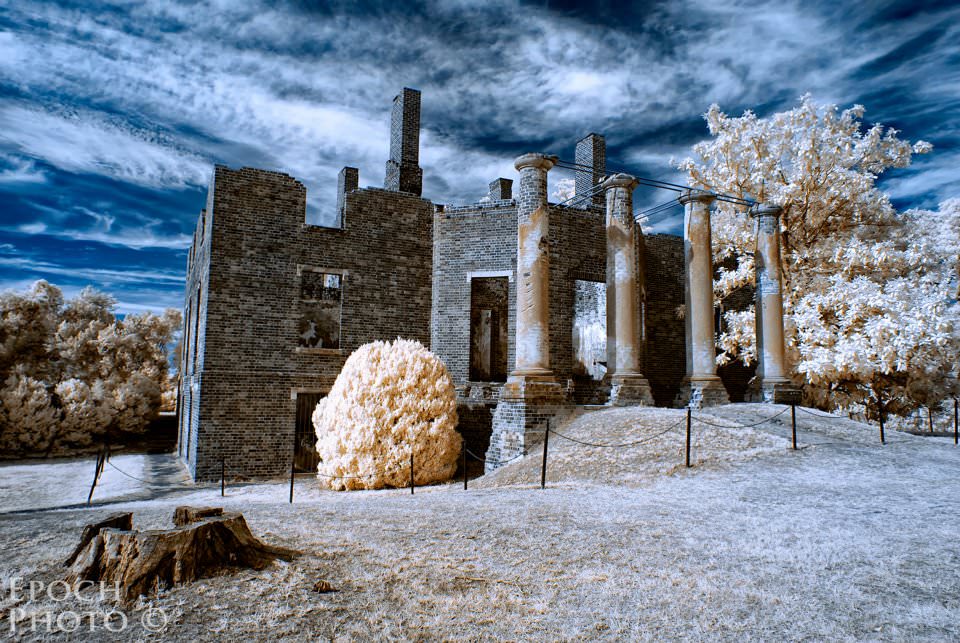
Terminology
For purposes of this article, I will refer to the infrared light spectrum equally "near-infrared", or but, "IR". Near-infrared refers to the spectrum of light just beyond the range humans can observe with their eyesight. This light range is between 700 – 1200 nm (nanometers). Another aspect of the IR spectrum, above near IR, is associated with thermal imaging. Thermal technology was popularized by movies such as, "Patriot Games" and other thrillers, whereby intelligence agencies or armed forces personnel were able to notice villains by measuring their torso rut nether nighttime conditions. Today's mutual digital camera sensors are not able to discover thermal images. Under the right circumstances even so, digital cameras can exercise an excellent task of recording IR.
History Of Infrared Photography
The starting time forays into IR photography, using special moving picture plates, began in the early part of the 20th century. During WWI, IR photography proved extremely valuable, as images using the IR spectrum were not affected equally much past atmospheric brume every bit normal photos. IR images were besides able to prove stark distinctions betwixt vegetation and buildings, better identifying potential enemy targets such equally camouflaged munitions factories and other central sites. Rivers, streams, lakes, and other waterways were depicted in a very dark hue, making them much more than obvious.
During the 1930s and 1940s, filmmakers introduced a variety of infrared-sensitive films that attracted both apprentice photographers and Hollywood filmmakers. The military extended its use of IR photography likewise, equally it sought every possible advantage during WWII. During the 1960s, IR photography saw a number of converts, as some of the leading musicians of the day, such as the Grateful Dead and Jimmy Hendrix, popularized its use via their psychedelic album covers. With the advent of the digital camera in the late 1990s, both regular and IR photography were well-nigh to modify substantially. In addition to professional and amateur photographers, police enforcement officials rely on IR photography to find forensic evidence non discerned through normal eyesight.
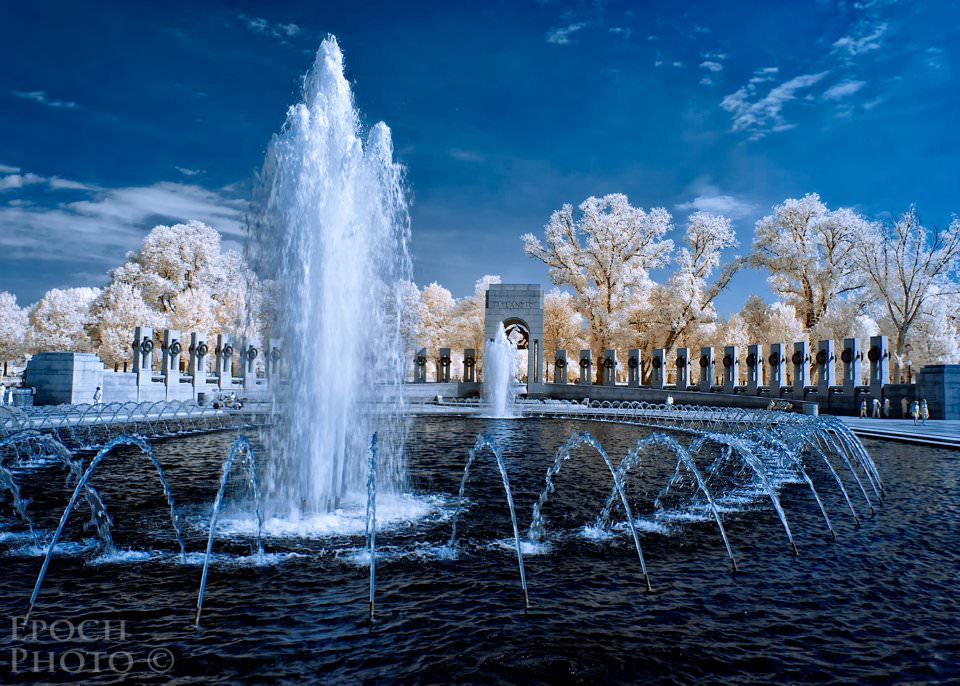
IR Lite Qualities
Reflected IR lite produces a fascinating assortment of surreal effects. Vegetation appears white or near white. Skin takes on a very milky, smooth texture, although veins shut to the skin surface can be accentuated and have on a rather ghoulish appearance. Optics can announced a bit ghostly with the irises registering very night tones and the whites of the center taking on a grayish hue. Black clothing can appear greyness or white depending on the textile. IR light can laissez passer through sunglasses that, to the center, appear extremely dark or mirror-like (see image below). Bluish skies take on a much more dramatic appearance as well.
The other aspect of IR photos is a bit tougher to describe and classify. I have found that there is a certain blazon of contrast, or what I refer to every bit "crispness", rarely seen in normal photography. High dissimilarity B&W images are the closest in nature to IR photography, merely even those don't seem to have the same look and feel every bit IR images. These effects and others are what provide the magic of IR photography – just most everything looks very dissimilar from what you are used to seeing within the visible light spectrum.
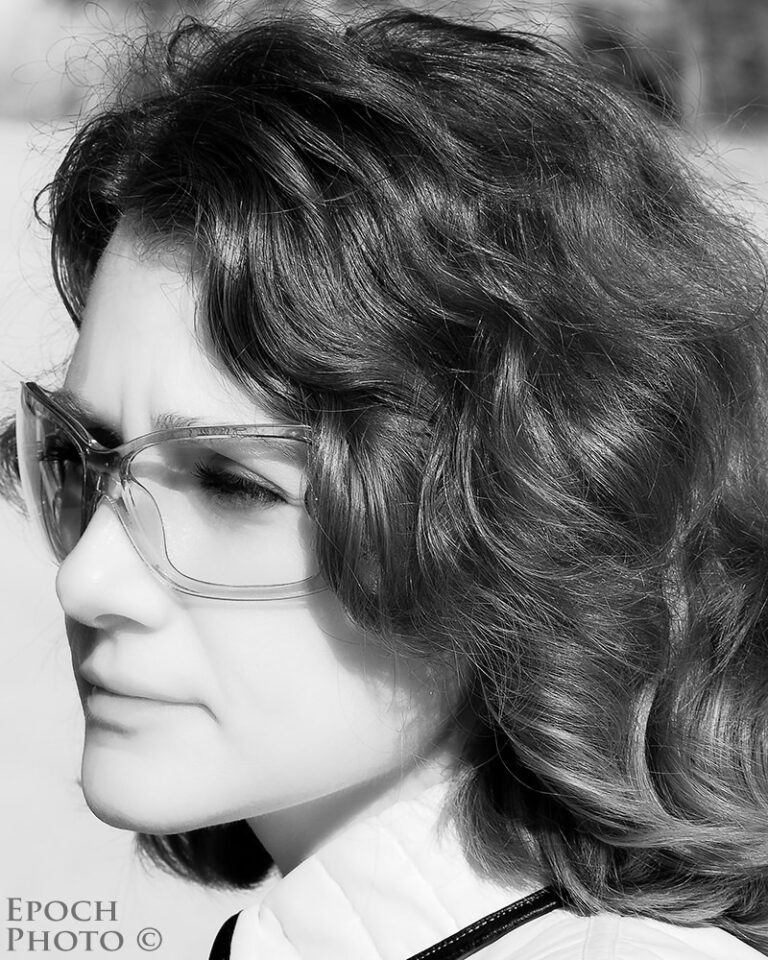
IR calorie-free passing through sunglasses and skin smoothing effect
IR Photography Options
35mm IR pic is nevertheless readily available for as lilliputian as $xi for a roll of 36 prints. It is easy enough to use in your existing SLR, thus enabling y'all to experiment with IR photography, without committing to anything more than a roll or two of moving-picture show, and some evolution costs. Depending on your lab's capabilities, still, you may observe that you have to ship the IR motion-picture show to some other lab that has the ability to process information technology, much as is required for high-end B&Due west film.
Another alternative requires buying a circular IR filter (like to a UV or round polarizing filter) that attaches to the forepart of your photographic camera lens. The IR filter prevents visible light from passing through while only allowing IR low-cal to strike your camera's sensor. These filters will vary in toll depending on the size of the filter and the specific portion of the IR spectrum they address. The main difference between the filters is how colors are rendered (more on this in a bit), just this is primarily a thing of taste. Spending more coin on a filter that focuses on a dissimilar office of the IR spectrum doesn't necessarily guarantee that yous will similar the results more than an IR filter costing much less.
What are the downsides of using an IR filter that attaches to your lens? The primary issue is movement blur. Since your DSLR has an IR blocking filter in forepart of it, very little, if any, IR lite reaches it. The IR filter allows merely IR calorie-free to reach your sensor while filtering out the visible low-cal. The combination of the IR blocking filter and the IR filter on the front of your lens requires very long exposure times. Since the IR filter is very dark, y'all also take to focus earlier attaching the IR filter to your lens.
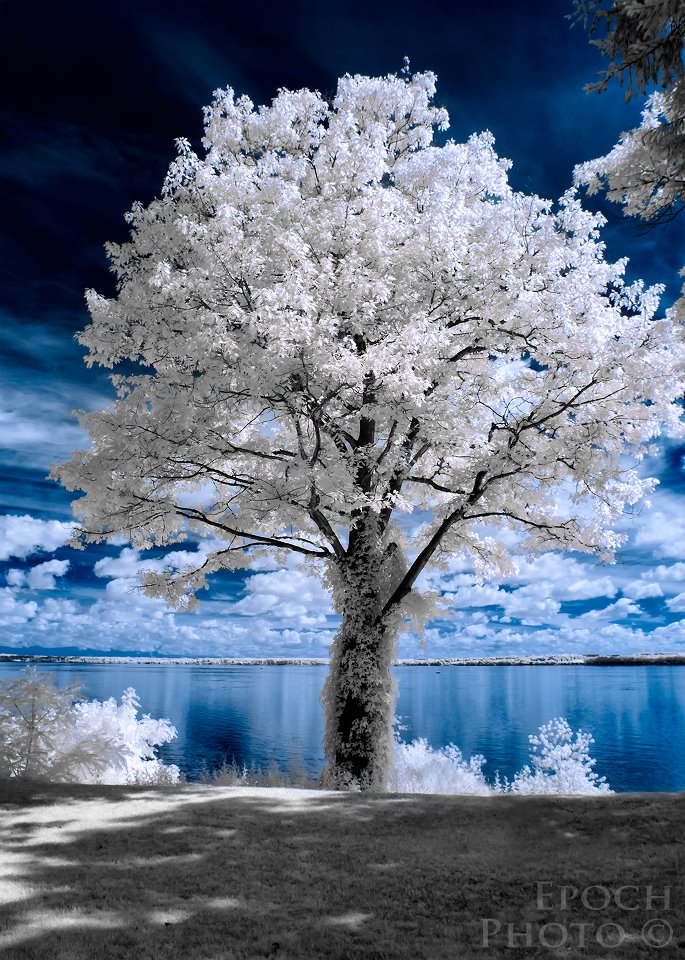
The specific exposure time will vary based on the specific IR filter used, sensitivity of the camera sensor to IR, the specifics of the DSLR'south blocking filter, and of form, the amount of IR light. When I starting time experimented with IR photography using my Pentax K10D in 2007, I institute that I needed to exit my shutter open for 45-60 seconds on a sunny summertime day to get a properly exposed IR photograph. That might be fine if you are taking photos of buildings or other inanimate objects, but doesn't work then well with anything that moves, such as people, animals, leaves, flowers, etc. But if yous want to become into IR photography quickly with minimal investment, you could buy an IR filter such every bit the Hoya R72 for as trivial as $64 (depending on the filter size required) and decide if it is for you. The R72 is probably the most popular IR filter, since it addresses a broad spectrum of the IR range, is economical, and produces excellent IR images.
The last option is to have a DSLR converted for exclusive IR use. This is more costly, but information technology produces the best results and offers the most flexibility.
DSLRs Converted For Dedicated IR Photography
This option requires the IR blocking filter that sits in front end of your DSLR's sensor to be removed, and substituted with one that allows only IR light to be passed through. It is the equivalent of taking the external IR filter I previously described and substituting it for the IR blocking filter. What are the benefits of this arroyo? Y'all can employ your DSLR just every bit you practice today, relying on normal exposure values and shutter speeds. Looking over my IR photo metadata, I have establish that on a typical sunny mean solar day from May through August, at f/8 and ISO 100, I achieved shutter speeds of at least 1/125 and often much college. No long exposures, no fourth dimension focusing and so needing to shift your focus mode from AF to manual, no fiddling with IR filters on the front of your lens. Most importantly – no blurred images.
The cons of using a defended IR camera are cost, the inability to utilize the converted camera for anything other than IR photography, and voiding your DSLR's warranty (gulp!). You have 2 options relative to converting a DSLR for IR apply:
- Send it to a reputable IR conversion company
- Practice information technology yourself
I would strongly recommend option one unless you are comfy with the following: watching an instructional video, existence very comfortable with very small, sensitive electrical components (heavy-duty consumers of caffeine tin terminate here!), disassembling your photographic camera to attain the sensor in an ultra-make clean surround, removing the IR blocking filter, replacing it with the IR filter obtained from the conversion company, putting your camera back together, and dealing with any trivial issues such as… grit, hairs, and other particles getting in your camera, as well as any operational issues encountered by some attribute of the disassembly/assembly procedure. While I accept seen the instructional video, and corresponded with a number of people that accept performed this performance, I would only say that it is not for the faint of heart!
There are a diverseness of companies that specialize in infrared conversion services. One of the most well-known is Lifepixel. I used Lifepixel on two occasions and accept nothing but praise for the professionalism of their staff and the quality of their work. Lifepixel showtime converted my Nikon D40X. Two years later, I sent them my D90. I have to acknowledge that I felt quite a bit of trepidation when I outset shipped my Nikon D40X to Lifepixel. The D40X was brand new and I didn't even have a single film with it before sending it off in a well-padded box. Something did not feel correct most sending a make new camera to someone other than Nikon to disassemble, modify, and in the process, voiding my warranty!
Before doing so, notwithstanding, I spoke extensively with Daniel, one of Lifepixels client support representatives. I emailed him with an exhaustive list of questions and concerns. Daniel was extremely patient and thoroughly addressed every issue I raised. Other Lifepixel representatives were but as responsive and helpful. And in nearly iv years of shooting IR, I can't bespeak to a single problem with either of the IR-converted DSLRs. I give-and-take of caution – whichever company you select for your IR conversion, make certain that you investigate them thoroughly and feel confident in having them modify your DSLR.
Capturing IR Images
Since the DSLR has been modified for IR merely purposes, you can utilise it merely as you lot did when photographing images within the visible light spectrum. ISO, shutter speed and aperture combinations volition work in conjunction with one some other but equally they practise with whatever non-IR DSLR. Matrix metering is always a safe bet with IR, although yous may want to experiment with your camera, lens, and lighting conditions to determine if center-weighted metering provides better results in a given situation.
My D40x required me to suit the exposure compensation button at times, dialing up/downward by as much as 1.7. Normally, the range of adjustment was smaller – +/- .3 – .seven. Although I have the same IR filter on my D90 however, I have noticed that the D90 requires much less adjustment of the exposure compensation. This was likely a consequence of the D90 and D40X using different camera sensors. Information technology takes a bit of trial and error to understand what a "good" RAW image looks like in your LCD. With time, notwithstanding, you will come to recognize when yous have properly exposed an IR image and if you demand to adjust the exposure bounty.
What Virtually Lenses?
Nosotros are trained to believe that the best lenses will produce the best results. However, in the world of IR, the lens that works best in the visible spectrum can exist a consummate dud in the world of IR. Conversely, lower-toll lenses may perform much better than their counterparts. The primary flaws with poor IR performing lenses are twofold; producing a hotspot in the center of the image (slightly unlike exposure and colors than the rest of the image), and being more than susceptible to flare. You may minimize the appearance of the hotspot in post-processing, but it tin can take quite a flake of work.
And simply equally with flares associated with the visible low-cal spectrum, IR flares cannot easily be fixed without extensive Photoshop piece of work. Worse, IR flares are harder to notice. When photographing in the visible light spectrum, you can oft tell when you are on the verge of introducing a flare based on the angle of the lens relative to the dominicus. With IR all the same, y'all don't always receive the same visible cue, since you can't see IR light. Thus it is important to bank check your LCD as yous shoot IR to ensure that yous are not introducing flares into your photos since you cannot trust your eyes.
The best strategy is to employ lenses that are known to work well for IR photography. Such knowledge isn't easy to come across. While you tin can always notice a myriad of quality lens reviews, few, if any, accost the result of IR performance. One such source is Bjorn Rorslett's site. Roreslett is one of the few that specifically tests lenses for IR use. Equally you can encounter from his site, the apprehensive Nikon 18-55mm is an fantabulous performer compared to another lenses costing a healthy multiple of its price. Over the years, I take come to rely heavily on my Nikon 16-85mm VR. It rarely comes off my infrared D90, since information technology provides splendid IR operation, is extremely abrupt, and has a very useful zoom range that covers just nigh annihilation I would wish to capture. And since I have a diversity of lenses and experimented with their IR functioning, I can vouch for many of Roreslett's IR recommendations.
Processing IR Images
RAW files afford the nigh flexibility for mail service-processing IR images, just as they do for photos taken with visible light. The RAW images viewed straight from the photographic camera are not very impressive – deadening, pinkish in color, lacking in contrast. RAW images from an infrared DSLR would probable not persuade many people to delve much deeper into this style of photography. The IR image beneath (Pennsylvania Memorial in Gettysburg, PA) possesses a decent contrast level, just others can appear blander or "muddied".

What gives it this pinkish tone? A number of factors influence the wait of the RAW IR image – the specific DSLR sensor used, the IR filter installed on the DSLR by the IR conversion company, and software algorithms used for white balance elevation the list. IR images actually have no color to them, but your DSLR's sensor has to assign something to the red, green, and blue sensors associated with the Bayer pattern. While each camera'due south IR images will announced slightly different than those of others, most mod DSLRs will produce a RAW file that looks somewhat like to the image above.
I process my IR images in Adobe Photoshop Lightroom, using a preset that serves as a good starting signal for adjusting the white residue, tone, dissimilarity, sharpening, etc. The near of import of these settings is the white balance, which I set to a temperature of 2100 and a tint of -72. The resultant epitome looks like the one beneath. Now the paradigm is shaping up and looks much better than the sea of pink from the original RAW file. Warning: Changing the white balance settings of IR images can consequence in some drastic psychedelic experiences!
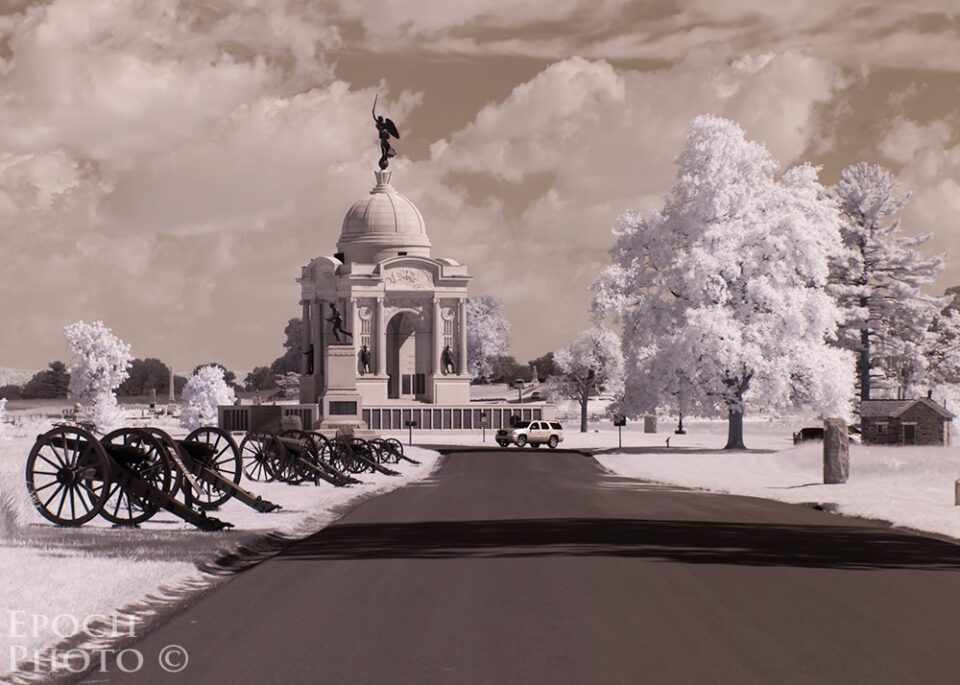
I then import the image above into Adobe Photoshop CS5, where I have created a few deportment that swap the scarlet and blueish channels to varying degrees. I am partial to a series of actions that outcome in a mixture of blue and yellow colors. How did I arrive at these settings? Pure experimentation… When I discover a particular expect that I like, I quickly create a Photoshop action while I have all the settings in plain view and tin can remember the associated steps. Sometimes I will reduce the colour saturation depending on what I am attempting to achieve and/or the nature of the epitome in question. Other times, I will modify the hue of a given colour. Once more, since IR does not incorporate any existent colors, those that yous run across are the result of a myriad of factors that will vary from camera to photographic camera. Thus my Lightroom presets and Photoshop actions might produce somewhat different results if applied to photos taken with your specific IR converted photographic camera make and model.
Below is the final version, after some additional processing, racket reduction, and sharpening:

Summary
IR photography opens up exciting new worlds for photographers to explore, especially considering the flexibility that IR converted DSLRs provide. This article is simply an introduction to the various bug and considerations associated with IR. If you lot would similar to empathise more than about this subject, drop me a note beneath, and I will be sure to cover additional aspects of IR photography in time to come manufactures.
Update:
Since I wrote this commodity and others related to infrared photography, many people have emailed me with questions related to IR and advice regarding IR conversion services. Over the final few years, I have recommended Kolari Vision. Kolari Vision has converted iv DSLRs for me. I have been very impressed with the quality of the service, turnaround time, value, and performance of the IR converted DSLRs. Ilija Melentijevic, Kolari Vision's founder, has been especially patient and helpful in explaining the technical and nuanced aspects of converting and using digital cameras for infrared photography. Kolari Vision offers a full range of infrared, ultraviolet, and other specialized digital camera solutions and related filters.
Source: https://photographylife.com/introduction-to-infrared-photography
Posted by: huertareplads.blogspot.com


0 Response to "Will Ir Block Lens Work On Ir Sensitive Camera?"
Post a Comment